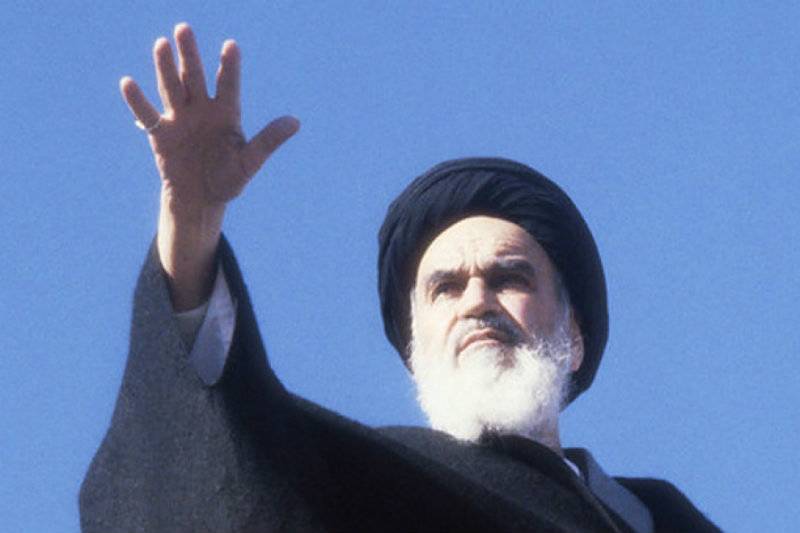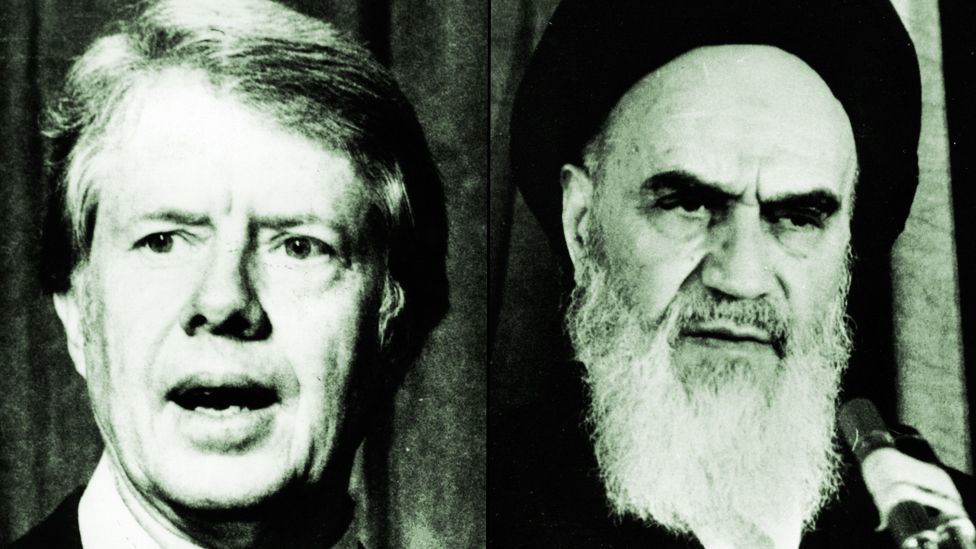Latest
America helped Iran’s Ayatollah Khomeini become leader of 1979 Revolution: declassified documents
02:16 PM | 8 Jun, 2016

TEHRAN (Web Desk) - In the official Iranian narrative of the 1979 Islamic Revolution, Ayatollah Ruhollah Khomeini - founder of Iran's Islamic Republic - bravely defied the United States and defeated "the Great Satan" in its desperate efforts to keep the Shah in power.
But a trove of declassified US government documents reveals that Khomeini was far more engaged with the US than either government has ever admitted.
Far from defying America, the Ayatollah courted the Carter administration on numerous occasions and delivered quiet signals that the potential Islamic Republic would be amenable to US interests.
According to the documents, the defiant leader of the Iranian revolution at the time of his exile in Paris effectively offered the President Carter administration a deal: “Iranian military leaders listen to you but the Iranian people follow my orders,” he said.

If President Jimmy Carter could use his influence on the military to clear the way for his takeover, Khomeini suggested, he would calm the nation. Stability could be restored, and America's interests and the citizens in Iran would be protected.
Declassified documents - including diplomatic cables, policy memos, meeting records - tell the largely unknown story of America's secret engagement with Khomeini and provide a detailed account of how Khomeini brokered his return to Iran using a tone of deference and amenability towards the US, the BBC reported.
At the time, the Iran was in chaos. Protesters clashed with troops, shops were closed, and public services suspended. Meanwhile, labor strikes had all but halted the flow of oil out of the country, jeopardizing a vital Western interest.
Persuaded by Carter, Iran's autocratic ruler, Mohammad Reza Shah Pahlavi, known as the Shah, had finally departed on a "vacation" abroad, leaving behind an unpopular prime minister and a military in disarray - a force of 400,000 men heavily dependent on American arms and advice.
Khomeini feared the nervous military since its royalist top brass hated him. Even more worrying for Khomeini, was their daily meetings with a US Air Force General by the name of Robert E Huyser, whom President Carter had sent on a mysterious mission to Tehran.
The ayatollah was determined to return to Iran after 15 years in exile and make the Shah's "vacation" permanent. So he made a personal appeal.
In a first-person message, Khomeini told the White House not to panic at the prospect of losing a strategic ally of 37 years and assured them that he, too, would be a friend.
"You will see we are not in any particular animosity with the Americans," said Khomeini, pledging that his Islamic Republic would be "a humanitarian one, which will benefit the cause of peace and tranquillity for all mankind."
To this day, former Carter administration officials maintain that Washington - despite being sharply divided over the course of action - stood firm behind the Shah and his government.
But the documents paint a different picture of US behaviour behind the scenes. Only two days after the Shah departed from Tehran, the US told a Khomeini envoy that they were - in principle - open to the idea of changing the Iranian constitution to abolish the monarchy. And they gave the ayatollah a key piece of information - Iranian military leaders were flexible about their political future.
What transpired four decades ago between America and Khomeini is not just diplomatic history. The US desire to make deals with what it considers pragmatic elements within the Islamic Republic continues to this day. So does the staunchly anti-American legacy that Khomeini left for Iran.
But a trove of declassified US government documents reveals that Khomeini was far more engaged with the US than either government has ever admitted.
Far from defying America, the Ayatollah courted the Carter administration on numerous occasions and delivered quiet signals that the potential Islamic Republic would be amenable to US interests.
According to the documents, the defiant leader of the Iranian revolution at the time of his exile in Paris effectively offered the President Carter administration a deal: “Iranian military leaders listen to you but the Iranian people follow my orders,” he said.

If President Jimmy Carter could use his influence on the military to clear the way for his takeover, Khomeini suggested, he would calm the nation. Stability could be restored, and America's interests and the citizens in Iran would be protected.
Declassified documents - including diplomatic cables, policy memos, meeting records - tell the largely unknown story of America's secret engagement with Khomeini and provide a detailed account of how Khomeini brokered his return to Iran using a tone of deference and amenability towards the US, the BBC reported.
At the time, the Iran was in chaos. Protesters clashed with troops, shops were closed, and public services suspended. Meanwhile, labor strikes had all but halted the flow of oil out of the country, jeopardizing a vital Western interest.
Persuaded by Carter, Iran's autocratic ruler, Mohammad Reza Shah Pahlavi, known as the Shah, had finally departed on a "vacation" abroad, leaving behind an unpopular prime minister and a military in disarray - a force of 400,000 men heavily dependent on American arms and advice.
Khomeini feared the nervous military since its royalist top brass hated him. Even more worrying for Khomeini, was their daily meetings with a US Air Force General by the name of Robert E Huyser, whom President Carter had sent on a mysterious mission to Tehran.
The ayatollah was determined to return to Iran after 15 years in exile and make the Shah's "vacation" permanent. So he made a personal appeal.
In a first-person message, Khomeini told the White House not to panic at the prospect of losing a strategic ally of 37 years and assured them that he, too, would be a friend.
"You will see we are not in any particular animosity with the Americans," said Khomeini, pledging that his Islamic Republic would be "a humanitarian one, which will benefit the cause of peace and tranquillity for all mankind."
To this day, former Carter administration officials maintain that Washington - despite being sharply divided over the course of action - stood firm behind the Shah and his government.
But the documents paint a different picture of US behaviour behind the scenes. Only two days after the Shah departed from Tehran, the US told a Khomeini envoy that they were - in principle - open to the idea of changing the Iranian constitution to abolish the monarchy. And they gave the ayatollah a key piece of information - Iranian military leaders were flexible about their political future.
What transpired four decades ago between America and Khomeini is not just diplomatic history. The US desire to make deals with what it considers pragmatic elements within the Islamic Republic continues to this day. So does the staunchly anti-American legacy that Khomeini left for Iran.


Advertisement
-
Anchor schools man for forcefully covering her with Dupatta without her ...
10:54 AM | 20 Apr, 2024 -
Pakistan’s Foreign Minister hopeful of new IMF loan agreement in May
10:31 AM | 20 Apr, 2024 -
PAKvNZ: Pakistan lock horns with New Zealand in second T20 today
10:01 AM | 20 Apr, 2024 -
US sanctions Chinese, Belarusian firms for aiding Pakistan’s ballistic ...
09:32 AM | 20 Apr, 2024 -
Pakistani PM calls UAE President to discuss Climate Change Response after ...
09:02 AM | 20 Apr, 2024
Pakistani rupee rate against US Dollar, Euro, Pound, Riyal - Check 20 April forex rates
Pakistani currency remains marginally same against US Dollar and other currencies on April 20, 2024. US dollar was being quoted at 277.5 for buying and 280.5 for selling.
Euro comes down to 293 for buying and 296 for selling while British Pound stands at 342.25 for buying, and 345.65 for selling.
UAE Dirham AED was at 75.25 and Saudi Riyal's new rates was at 73.30.
Today’s currency exchange rates in Pakistan - 20 April 2024
Source: Forex Association of Pakistan. (last update 09:00 AM)
| Currency | Symbol | Buying | Selling |
|---|---|---|---|
| US Dollar | USD | 277.5 | 280.5 |
| Euro | EUR | 293 | 296 |
| UK Pound Sterling | GBP | 342.5 | 346 |
| U.A.E Dirham | AED | 75.2 | 75.9 |
| Saudi Riyal | SAR | 73.3 | 74.05 |
| Australian Dollar | AUD | 181 | 182.8 |
| Bahrain Dinar | BHD | 740.55 | 748.55 |
| Canadian Dollar | CAD | 201 | 203 |
| China Yuan | CNY | 38.47 | 38.87 |
| Danish Krone | DKK | 39.78 | 40.18 |
| Hong Kong Dollar | HKD | 35.53 | 35.88 |
| Indian Rupee | INR | 3.33 | 3.44 |
| Japanese Yen | JPY | 1.86 | 1.94 |
| Kuwaiti Dinar | KWD | 903.11 | 912.11 |
| Malaysian Ringgit | MYR | 58.08 | 58.68 |
| New Zealand Dollar | NZD | 164.22 | 166.22 |
| Norwegians Krone | NOK | 25.61 | 25.91 |
| Omani Riyal | OMR | 723.2 | 731.2 |
| Qatari Riyal | QAR | 76.45 | 77.15 |
| Singapore Dollar | SGD | 204.5 | 206.5 |
| Swedish Korona | SEK | 25.31 | 25.61 |
| Swiss Franc | CHF | 305.47 | 307.97 |
| Thai Bhat | THB | 7.56 | 7.71 |
Advertisement
Lifestyle
Blogs
- Who is the most followed Pakistani actor on Instagram? 09:55 PM | 3 Apr, 2024
- Forbes 2024 List of World's Billionaires is out now: Taylor Swift, ChatGPT founder enter elite ranks 12:12 PM | 3 Apr, 2024
- Pakistan's ranking improves by 7 spots in Transparency International Corruption index 01:52 PM | 30 Jan, 2024
- Pakistan Army ranked among top 10 strongest militaries in the world 01:42 PM | 17 Jan, 2024
- 10 Top Google searches made by Pakistanis in 2024 09:36 PM | 20 Mar, 2024
- Famous People Who Passed Away in 2023 08:35 PM | 26 Dec, 2023
Follow us on Facebook
Follow us on Twitter
Sign up for Newsletter
Copyright ©2024. Reproduction of this website's content without express written permission from 'Daily Pakistan' is strictly prohibited.
